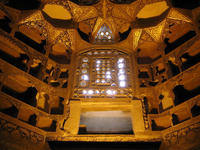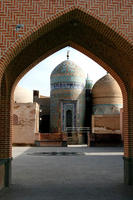You are in: Middle East -> Iran -> Sheikh Safi al-din K... , and traditional search or Image Gallery will yield results of this site only
Sheikh Safi al-din Khānegāh and Shrine Ensemble in Ardabil
| Site number: | 1345 |
|
| Type of site: | Cultural | |
| Date: | 16-18 centuries | |
| Date of Inscription: | 2010 | |
| Location: | Middle East, Iran (Islamic Republic of), Ardabil | |
Up to 75 images are shown here. Click on each for more details or on Image Gallery for more images.
| Description: | The Sufi spiritual retreat was built between the early 16th century and late 18th century, using traditional Iranian architectural forms. Manufacturers have been able to take full advantage of the reduced space for multiple functions, among them - a library, a mosque, a school, a mausoleum, a cistern, a hospital, kitchens, a bakery and some offices. The site includes a path leading to the shrine of Sheikh divided into seven steps that reflect the seven stages of Sufi mysticism, separated by eight gates which represent the eight attitudes of Sufism. The site also includes interiors and facades richly ornamented, and a remarkable collection of antiques. It forms a rare collection of medieval Islamic architectural elements --WHMNet paraphrase from the description at WHC Site, where additional information is available. | |
| Sheikh Safi al-Din Khānegāh and Shrine Ensemble (Persian: مجموعه آرامگاه و خانقاه شیخ صفی الدین) is the tomb of Sheikh Safi located in Ardabil, Iran. In 2010, it was registered on the UNESCO World Heritage List. The Mausoleum of Sheikh Safi, in Ardabil, was built by his son Sheikh Sadraddin, after Sheikh Safi’s death in 1334. The mausoleum consists of many sections that have served a variety of functions over the past centuries, including a library, a mosque, a school, mausolea, a cistern, a hospital, kitchens, a bakery, and some offices. It incorporates a route to reach the shrine of the sheikh divided into seven segments, which mirror the seven stages of Sufi mysticism. Various parts of the mausoleum are separated by eight gates, which represent the eight attitudes of Sufism. Several parts were gradually added to the main structure during the Safavid dynasty. A number of Safavid sheikhs and harems and victims of the Safavids’ battles, including the Battle of Chaldiran, have been buried at the site. --Wikipedia. Text is available under the Creative Commons Attribution-ShareAlike License. | ||
| Source: | http://whc.unesco.org/en/list/1345 | |
| Reference: | 1. UNESCO World Heritage Center (http://whc.unesco.org/en/list/1345). 2. Wikipedia. | |
























